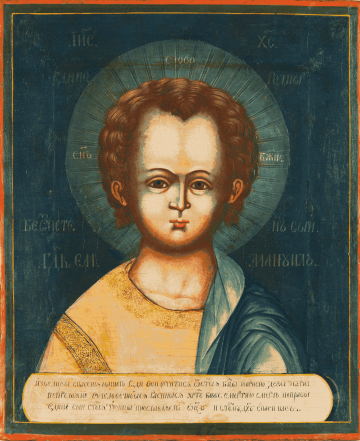Christ Emanuel
(Russia; eighteenth century)
Russia; eighteenth century; 30.7 x 25.6 cm
Feast: Throughout the year
Iconography
This type of iconography of Christ appears early, no later than the sixth century. Icons of this type depict Christ in the form of a child, but with the features of an adult, an intellectually and spiritually mature man. Such a depiction of Christ was a response to the Nestorian heresy of the fifth century, denying the divine nature of Jesus Christ until his baptism. The main source of this iconographic type of Christ is the Gospel account of the birth of Christ, as the fulfilment of Isaiah's prophecy: “And she will bring forth a Son, and you shall call His name Jesus, for He will save His people from their sins.” So all this was done that it might be fulfilled which was spoken by the Lord through the prophet, saying: “Behold, the virgin shall be with child, and bear a Son, and they shall call His name Immanuel, which is translated God with us.” (Matthew 1:21-23).
This iconographic type is a symbol of the pre-eternal Word of God (Greek Λόγος) that became the body. He is most frequently depicted up to the shoulders, either alone or in the presence of the Blessed Virgin, Saint John the Baptist, or angels. As on all the icons of Christ, the typical cross in the aureole is included on this type of Saviour – Emanuel.
Description of the icon
The icon depicts Jesus Christ as a twelve-year-old boy up to his shoulders, with an emphasis on the facial expression. The high forehead signifies the wisdom and depth of knowledge that Christ had as the Son of God, as confirmed by the words of the Gospel of Saint Luke: “And the Child grew and became strong in spirit, filled with wisdom; and the grace of God was upon Him.” (Luke 2:40). “Now so it was that after three days they found Him in the temple, sitting in the midst of the teachers, both listening to them and asking them questions. And all who heard Him were astonished at His understanding and answers. So when they saw Him, they were amazed; and His mother said to Him, “Son, why have You done this to us? Look, Your father and I have sought You anxiously.” And He said to them, “Why did you seek Me? Did you not know that I must be about My Father’s business?” But they did not understand the statement which He spoke to them.” (Luke 2:46-50).
Christ has a blue aureole around his head illuminated by rays of light at regular intervals. The shading of the rays gives the impression that light is radiating out of Him. Even the clear gaze and the alabaster face of Emanuel amplify this impression of the Word in the image when He Himself said, “I am the light of the world. He who follows Me shall not walk in darkness, but have the light of life.” (John 8:12)
The under garment is golden-yellow in colour with gold edging around the neck and a clavus (a colored stripe on a tunic, serving to denote rank or office), with a sign of priestly power on the right shoulder. Gold and yellow symbolize God's glory and supernatural light, and these colours, together with the carefully groomed short hair, also relate of the noble origin of the Son of God. He has a himation, a blue mantle in paler and darker shades, draped over the left shoulder on the chiton (хитон, the under garment). This colour is also used for the background of the icon. It confirms the mystery of God's Word incarnated among people and transcending all earthly things, in terms of the meaning.
There is a text, the Greek initials of His name, in the background and in the aureole: IC XC (Ιησούς Χριστός) and further in lines the Word, the Only Begotten Son of God, the Almighty, God, Emanuel.
The text at the bottom of the icon, which is also part of the liturgy of Saint John Chrysostom and Saint Basil the Great, comes according to general tradition from the Byzantine Emperor Justinian I (527 - 565), which is also confirmed by the Byzantine historian Theophanes. This hymn was created as a response of the church to the two heresies of the time, namely Nestorianism and monophysitism, which did not recognize the two natures of Jesus Christ.
Text on the bottom frame:
Единородный Сыне и Слове Божий, Безсмертен Сый, и изволивый спасения нашего ради воплотитися от Святыя Богородицы и Приснодевы Марии, непреложно вочеловечивыйся; распныйся же Христе Боже, смертию смерть поправый, един Сый Святыя Троицы, спрославляемый Отцу и Святому Духу, спаси нас.
Translation into English:
The Only-begotten Son and the Word of God, immortal, and yet you have received the body from the Holy Virgin and always Virgin Mary for our salvation, and without changing your deity you have become man. You have suffered the cross, Christ God, you have overcome death with death. As one in the Holy Trinity, equal in glory to the Father and to the Holy Spirit, save us.


